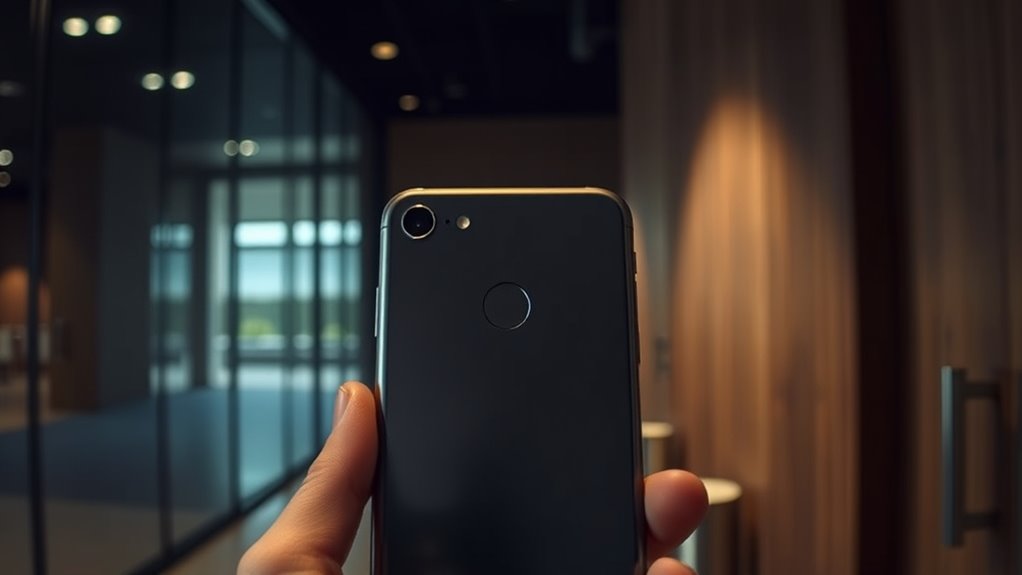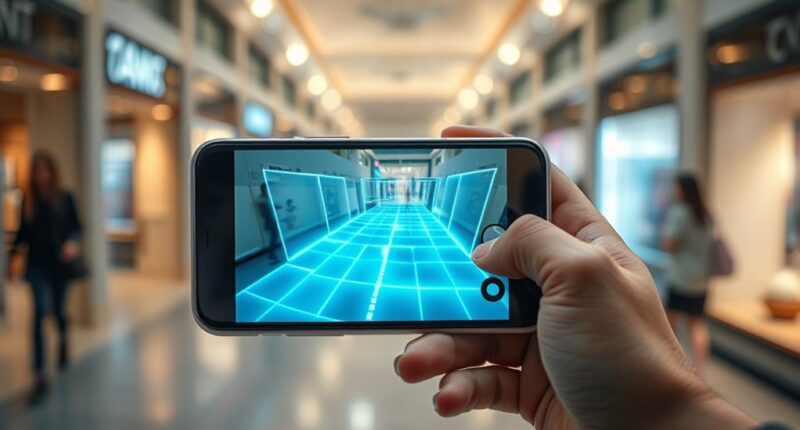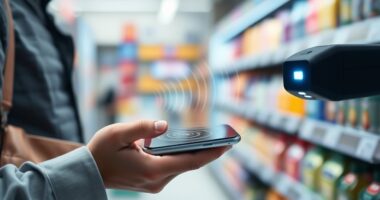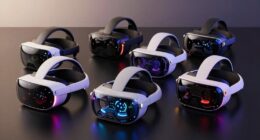LiDAR in smartphones is quietly revolutionizing indoor guidance by allowing you to create detailed 3D maps of complex spaces in real time. With this technology, your device can accurately detect obstacles, find pathways, and generate indoor maps even in cluttered or poorly lit environments. This makes navigating airports, malls, or hospitals faster and more precise. Keep exploring to discover how this innovative tech is transforming the way you move indoors.
Key Takeaways
- Enables real-time 3D indoor mapping, improving accuracy and detail over traditional navigation methods.
- Facilitates obstacle detection and pathway identification for safer indoor navigation.
- Allows smartphones to generate precise indoor maps in cluttered or low-light environments.
- Enhances wayfinding in complex spaces like airports, hospitals, and malls.
- Expands the accessibility of advanced navigation features to more users through widespread smartphone integration.

Have you ever wondered how your smartphone can create detailed 3D maps or enhance your AR experiences? The secret lies in LiDAR technology, which stands for Light Detection and Ranging. It uses pulsed laser light to measure distances with incredible precision. When you point your phone at an object or space, the LiDAR sensor emits invisible laser beams that bounce off surfaces and return, allowing the phone to calculate how far away those objects are. This process, called the time-of-flight principle, results in highly detailed 3D maps that help your device understand its environment better than traditional methods. LiDAR utilizes pulsed laser light to measure distances in 3D space, enhancing environmental understanding. Unlike earlier ToF sensors, LiDAR offers faster, more accurate, and higher-resolution depth mapping. This makes a noticeable difference in applications like augmented reality, where precise spatial understanding is essential. Industry giants such as automotive and aviation companies have long used LiDAR for navigation and obstacle detection. Now, it’s making its way into smartphones, transforming indoor navigation and other functionalities. On compatible devices like the iPhone 12 Pro and later models, LiDAR enables real-time 3D mapping that can be used for navigation inside complex buildings. This means your phone can generate accurate floor plans and models of indoor spaces such as airports, malls, or museums, helping you find your way without external assistance. The integration of LiDAR technology in consumer devices is expected to accelerate as manufacturers recognize its potential for diverse applications. Currently, Apple leads the market with its iPhones and iPads equipped with LiDAR sensors. Other major Android manufacturers, like Samsung and Huawei, are exploring or developing similar technology but haven’t yet released consumer devices with integrated LiDAR. Rumors suggest Chinese brands such as Oppo are working on LiDAR-enabled smartphones, hinting at broader adoption in the future. As the technology matures, industry experts expect more Android devices to incorporate LiDAR, making this feature more accessible. LiDAR enhances indoor navigation by creating detailed 3D models of spaces in real time. It allows your phone to detect obstacles, identify pathways, and generate accurate maps, even in cluttered or poorly lit environments. This capability supports sophisticated wayfinding in large, complex buildings, reducing confusion and saving time. For example, LiDAR-equipped phones can help you navigate airports, hospitals, or warehouses with pinpoint accuracy. The technology’s ability to generate dense spatial data means your phone can precisely understand and interpret indoor settings, making navigation smoother and more reliable. Over time, this quiet innovation will likely become a standard feature, transforming how smartphones help you move confidently through indoor environments.
Frequently Asked Questions
How Accurate Is Smartphone Lidar Compared to Dedicated Devices?
Smartphone LiDAR offers decent accuracy but falls short of dedicated devices. You can expect about 0.25 inches (6.35 mm) precision in ideal conditions, but inaccuracies beyond 0.75 inches (19 mm) can occur depending on the app and environment. While professional scanners like FARO deliver higher, more consistent accuracy, smartphones provide a faster, more affordable solution with some limitations in detail and range, especially for precise measurements.
Can Lidar in Phones Detect Moving Objects Indoors?
You might wonder if phone LiDAR can detect moving objects indoors. The answer is yes; it can. With real-time processing, LiDAR tracks moving objects by analyzing point cloud data, even in dynamic environments. Though there are some limitations like field of view, advancements have made indoor object detection quite effective. This technology is useful for applications like indoor navigation, robotics, and accessibility, making your experience smoother and more interactive.
What Privacy Concerns Arise With Phone-Based Lidar Mapping?
Like a silent observer in the shadows, phone-based lidar mapping raises privacy concerns. You might worry about data collection, even though lidar captures only spatial, non-biometric info. Ensuring compliance with privacy laws like GDPR, being transparent about data use, and implementing strong security measures help protect your privacy. It’s essential that you stay informed and trust that new tech advances prioritize your privacy, not compromise it.
How Does Lighting Affect Lidar Performance in Indoor Spaces?
Lighting conditions considerably impact your LiDAR’s accuracy indoors. Bright or flickering lights create noise and reflections that interfere with measurements, while dim lighting generally improves performance. You should be aware that reflective surfaces can cause errors, and overly bright lights may lead to false readings. To optimize your LiDAR, guarantee consistent, moderate lighting, and consider using filters or additional sensors to counteract environmental challenges for reliable indoor mapping.
Are There Limitations to Lidar Range on Smartphones?
You might think LiDAR on your phone has endless reach, but surprise—its range is limited to about 5 meters. This handy feature struggles with accuracy as distance increases, and multipath interference can throw off readings. While software tweaks and combining sensors help, don’t expect it to replace professional scanners anytime soon. Its real strength lies in short-range precision, making it perfect for AR and object detection, not long-distance navigation.
Conclusion
As LiDAR quietly weaves its magic into your phone, indoor navigation transforms into a seamless dance. No longer do you stumble through unfamiliar halls or maze-like stores; instead, you glide effortlessly, as if the building itself guides you with a gentle whisper. This tiny sensor is your unseen compass, lighting the way through the shadows. Soon, every step you take indoors will feel like a well-choreographed journey, all thanks to the quiet revolution happening in your pocket.









